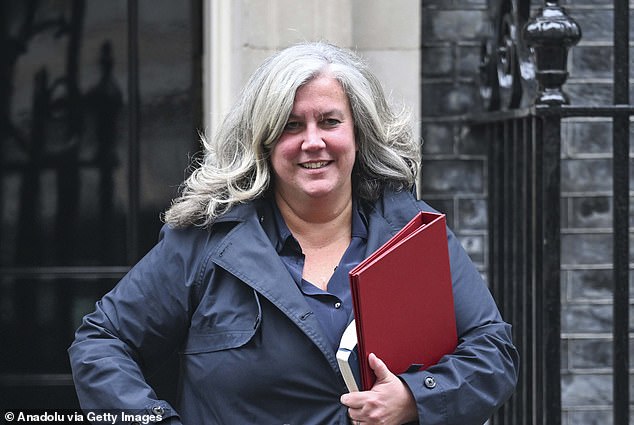Drivers older than 70 face taking eye tests every three years and could be banned if they fail them under planned new motoring laws.
The radical proposals could also see the the drink-drive limit in England in Wales lowered from 35mg of alcohol per 100ml of breath to 22mg per 100ml, as it is in Scotland.
The government’s plans are expected to be published this autumn, with some insiders suggesting that the motoring shake-up could be as drastic as those brought in by Sir Tony Blair in 2008, when he announced the Road Safety Act.
It could bring stricter punishments for uninsured drivers as well as motorists whose passengers fail to wear a seatbelt, if they already have points on their license.
There could also be tests for medical conditions like dementia introduced to assess a person’s fitness to drive.
It comes just months after a leading coroner wrote to Transport Secretary Heidi Alexander to say that the UKs licensing rules were the ‘laxest’ in Europe.
Dr James Adeley, senior coroner for Lancashire, issued a prevention of future deaths report after finding that four people had been killed by drivers with poor vision.
An inquest in Preston heard Mary Cunningham, 79, Grace Foulds, 85, Anne Ferguson, 75, and Peter Westwell, 80, had all died in traffic collisions where the driver had defective eyesight.

Drivers older than 70 face taking eye tests every three years and could be banned if they fail them under planned new motoring laws (Stock Image)

The radical proposals could also see the the drink-drive limit in England in Wales lowered from 35mg of alcohol per 100ml of breath to 22mg per 100ml, as it is in Scotland (Stock Image)

It comes just months after a leading coroner wrote to Transport Secretary Heidi Alexander (above) to say that the UKs licensing rules were the ‘laxest’ in Europe
Dr Adeley stated in his report: ‘The four fatalities shared the same feature that the driver’s sight was well below the standard required to drive a car.’
Tests for visual ability to drive have not changed since the 1930s – with the threshold remaining being able to read a registration plate from 20 metres away – or around 66ft.
Audi driver Glyn Jones, 68, ploughed into friends Mrs Cunningham and Mrs Foulds as they crossed a road in Southport on November 30, 2021.
He was unable to see due to a condition called severe ‘bilateral keratoconus’ but he ignored medical advice that his eyesight was too poor.
Mrs Ferguson was killed by van driver Vernon Law, 72, who had been to an optician a month before the crash in Rochdale in July 2023 and was told he had cataracts in both eyes. Following her death, her husband took his own life.
Pedestrian Mr Westwell was also struck and killed by a Honda Jazz driven by Neil Pemberton, 81, in Langho on March 17, 2022.

Government insiders suggest the motoring shake-up could be as drastic as those brought in by Sir Tony Blair (above) when he announced the Road Safety Act
Pemberton made no attempt to brake and was speeding at 48mph in 30mph zone.
The inquest heard Pemberton had a long history of severe bilateral eye disease and was twice warned he should not drive before he began to inform optometrists he was a non-driver. He repeatedly failed to self-report his condition.
In his prevention of future deaths notice, Dr Adeley told the Department of Transport (DfT): ‘In my opinion there is a risk that future deaths could occur unless action is taken.’
A government source told The Times that the latest initiatives were being brought in because ministers felt they had a ‘responsibility’ to start reduce instances of similar traffic accidents.
They said: ‘It cannot be right that one person is killed or seriously injured on our roads every 18 minutes. Just think of the impact on those people and their families. We cannot sit by and simply do nothing.’
The move has been praised by motoring chiefs across the country, with AA president Edmund King saying that the plans were ‘long overdue’.
King told the Daily Mail: ‘The time has come for a bold and proactive approach to road safety. If these policies are all included in the road safety strategy it would be a positive move which The AA and AA Charitable Trust would support.
‘This strategy is much overdue as road deaths have plateaued over the last decade.’
King, however, said there has been a ‘major oversight’ by leaving stricter restrictions on new drivers out of the measures.
The AA president said he was disappointed to not see new rules to ‘safeguard and to save new driver and passenger lives by limiting peer-age passengers for six months’.
RAC head of policy Simon Williams added that lowering the drink drive limit may not be adequate as a standalone policy to reduce road casualties.
He said: ‘Government data for Scotland suggests merely reducing the legal drink-drive limit isn’t enough.
‘A significant number of drink-drive offences are committed by reoffenders, so tackling the risk associated with habitual drink-drivers is crucial.
‘Motorists we’ve surveyed are supportive of repeat offenders having alcolocks fitted to their vehicles to stop them driving over the limit.
‘Greater scope for the police to deal with drug-drivers more quickly would also be very welcome.’
The Daily Mail has contacted the DfT for comment.












